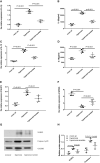Acetate Downregulates the Activation of NLRP3 Inflammasomes and Attenuates Lung Injury in Neonatal Mice With Bronchopulmonary Dysplasia
- PMID: 33614540
- PMCID: PMC7889800
- DOI: 10.3389/fped.2020.595157
Acetate Downregulates the Activation of NLRP3 Inflammasomes and Attenuates Lung Injury in Neonatal Mice With Bronchopulmonary Dysplasia
Abstract
Background: Bronchopulmonary dysplasia (BPD) is a common pulmonary complication in preterm infants. Acetate is a metabolite produced by the gut microbiota, and its anti-inflammatory function is well known. The role of acetate in BPD has not been studied. Here, we investigate the effects of acetate on lung inflammation and damage in mice model of BPD. Objective: To investigate the role of acetate in the development of BPD. Methods: C57BL/6 mice were randomly divided into three groups on the 3rd day after birth: room air group, hyperoxia group, and hyperoxia + acetate (250 mM, 0.02 ml/g) group. The expression of inflammatory factors was determined by ELISA and RT-PCR, and NLRP3 and caspase-1 were detected by Western blot. High-throughput sequencing was used to detect bacterial communities in the mice intestines. Results: After acetate treatment, the expression levels of TNF-α, IL-1β, IL-18, NLRP3, and caspase-1 were significantly reduced, while the expression of GPR43 was increased. In the BPD mice treated with acetate, the proportion of Escherichia-Shigella was lower than in placebo-treated BPD mice, while the abundance of Ruminococcus was increased. Conclusions: These results indicate that acetate may regulate intestinal flora and reduce inflammatory reactions and lung injury in BPD. Therefore, acetate may be an effective drug to protect against neonatal BPD.
Keywords: GPR43; acetate; bronchopulmonary dysplasia; inflammasome; microbial communities.
Copyright © 2021 Zhang, Ran, He, Ai and Shi.
Conflict of interest statement
The authors declare that the research was conducted in the absence of any commercial or financial relationships that could be construed as a potential conflict of interest.
Figures





Similar articles
-
Inhibition of Rac1 Signaling Downregulates Inflammasome Activation and Attenuates Lung Injury in Neonatal Rats Exposed to Hyperoxia.Neonatology. 2017;111(3):280-288. doi: 10.1159/000450918. Epub 2016 Dec 24. Neonatology. 2017. PMID: 28013306
-
Caspase-1 Inhibition Attenuates Hyperoxia-induced Lung and Brain Injury in Neonatal Mice.Am J Respir Cell Mol Biol. 2019 Sep;61(3):341-354. doi: 10.1165/rcmb.2018-0192OC. Am J Respir Cell Mol Biol. 2019. PMID: 30897338
-
Artesunate Alleviates Hyperoxia-Induced Lung Injury in Neonatal Mice by Inhibiting NLRP3 Inflammasome Activation.Evid Based Complement Alternat Med. 2023 Feb 4;2023:7603943. doi: 10.1155/2023/7603943. eCollection 2023. Evid Based Complement Alternat Med. 2023. PMID: 36785753 Free PMC article.
-
Inhalation or instillation of steroids for the prevention of bronchopulmonary dysplasia.Neonatology. 2015;107(4):358-9. doi: 10.1159/000381132. Epub 2015 Jun 5. Neonatology. 2015. PMID: 26044104 Review.
-
Mechanisms of inflammatory lung injury in the neonate: lessons from a transgenic mouse model of bronchopulmonary dysplasia.Semin Perinatol. 2010 Jun;34(3):211-21. doi: 10.1053/j.semperi.2010.02.006. Semin Perinatol. 2010. PMID: 20494738 Review.
Cited by
-
Characteristics and function of the gut microbiota in patients with IgA nephropathy via metagenomic sequencing technology.Ren Fail. 2024 Dec;46(2):2393754. doi: 10.1080/0886022X.2024.2393754. Epub 2024 Aug 23. Ren Fail. 2024. PMID: 39177227 Free PMC article.
-
Gut dysbiosis and long COVID-19: Feeling gutted.J Med Virol. 2022 Jul;94(7):2917-2918. doi: 10.1002/jmv.27684. Epub 2022 Mar 7. J Med Virol. 2022. PMID: 35233795 Free PMC article. No abstract available.
-
Mechanism of chlorogenic acid reducing lipopolysaccharide-induced acute lung injury in mice by regulating miR-223/NLRP3 axis.Zhong Nan Da Xue Xue Bao Yi Xue Ban. 2022 Mar 28;47(3):280-288. doi: 10.11817/j.issn.1672-7347.2022.240248. Zhong Nan Da Xue Xue Bao Yi Xue Ban. 2022. PMID: 35545320 Free PMC article. Chinese, English.
-
[Research Progress on the Protective Effect of Intestinal Flora on Radiation-induced Lung Injury in Thoracic Tumors].Zhongguo Fei Ai Za Zhi. 2023 Jun 20;26(6):467-472. doi: 10.3779/j.issn.1009-3419.2023.106.11. Zhongguo Fei Ai Za Zhi. 2023. PMID: 37488084 Free PMC article. Chinese.
-
A key role for NLRP3 signaling in preterm labor and birth driven by the alarmin S100B.Transl Res. 2023 Sep;259:46-61. doi: 10.1016/j.trsl.2023.04.004. Epub 2023 Apr 28. Transl Res. 2023. PMID: 37121539 Free PMC article.
References
LinkOut - more resources
Full Text Sources
Other Literature Sources
Miscellaneous

